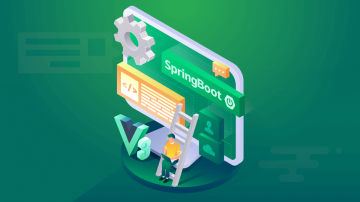本文介绍了Spring Boot项目开发入门的相关知识,包括Spring Boot的基本概念、开发环境搭建、第一个Spring Boot应用的创建以及常用功能的实现。文中详细讲解了数据库连接、日志配置、使用Spring Boot实现RESTful服务、集成Thymeleaf模板引擎和项目打包及部署等内容,并附有相应的代码示例。
Spring Boot项目开发入门教程1. Spring Boot简介
什么是Spring Boot
Spring Boot是一个基于Spring框架的微框架,旨在简化Spring应用程序的开发过程。它通过约定优于配置的原则减少了配置的复杂度,提供了一个一站式的微服务开发环境,使得开发者能够快速构建独立的、生产级别的应用。
Spring Boot的优势
- 简化配置:通过约定优于配置的原则减少了配置的复杂度。
- 快速启动:提供了一站式的微服务开发环境,可以快速启动应用。
- 无需XML配置:大多数情况下,Spring Boot应用不需要编写XML配置文件。
- 自动配置:可以根据应用的类路径自动配置应用。
- 支持嵌入式Servlet容器:可以内嵌Tomcat、Jetty或Undertow等容器。
- 具有生产就绪特性:包含一些内嵌的生产特性,如配置处理、内嵌Web服务器、监控等。
Spring Boot的基本概念
- 起步依赖:Spring Boot通过起步依赖简化了项目的配置。起步依赖是一个包含了多个依赖的依赖,它负责引入构建项目所需的所有依赖。
- 自动配置:Spring Boot会根据应用的类路径自动配置应用。例如,如果项目中引入了Spring Data JPA的依赖,Spring Boot会自动配置JPA相关的bean。
- 命令行工具:Spring Boot提供了一个命令行工具,可以快速创建Spring Boot项目。
2. 开发环境搭建
Java开发环境搭建
为了开发Spring Boot应用,首先需要安装Java开发环境。以下是安装步骤:
- 下载Java开发工具包(JDK):访问Oracle官方网站或其他可信赖的源下载JDK。
- 安装JDK:双击下载的安装包,按照安装向导完成安装。
- 配置环境变量:安装完成后,需要配置环境变量。
- 设置
JAVA_HOME指向JDK的安装路径。 - 设置
PATH环境变量包含%JAVA_HOME%\bin。
- 设置
Maven或Gradle构建工具配置
为了构建Spring Boot项目,需要配置构建工具。这里以Maven为例。
- 下载Maven:访问Maven官方网站下载Maven。
- 解压并安装Maven:解压下载的文件,配置环境变量。
- 设置
MAVEN_HOME指向Maven的安装路径。 - 设置
PATH环境变量包含%MAVEN_HOME%\bin。
- 设置
Spring Boot项目创建
- 使用Spring Initializr:Spring Initializr是Spring官方提供的项目创建工具,支持命令行和网页创建。
- 创建项目:通过命令行或网页创建一个新的Spring Boot项目。例如,通过命令行创建:
mvn archetype:generate -DgroupId=com.example -DartifactId=demo -DarchetypeArtifactId=spring-boot-starter-web -DarchetypeVersion=2.4.0 -DinteractiveMode=false- 导入项目:将创建的项目导入IDE中,如IntelliJ IDEA或Eclipse。
3. 第一个Spring Boot应用
创建Spring Boot项目
创建一个基本的Spring Boot项目,可以使用Spring Initializr或Maven命令行工具。以下是使用Maven命令行工具创建的示例:
mvn archetype:generate -DgroupId=com.example -DartifactId=simpleSpringBoot -DarchetypeArtifactId=spring-boot-starter-web -DarchetypeVersion=2.4.0 -DinteractiveMode=false编写简单的控制器和视图
创建一个简单的控制器,并定义一个处理HTTP请求的方法。
- 创建控制器类
package com.example.simpleSpringBoot;
import org.springframework.boot.SpringApplication;
import org.springframework.boot.autoconfigure.SpringBootApplication;
import org.springframework.web.bind.annotation.GetMapping;
import org.springframework.web.bind.annotation.RestController;
@RestController
@SpringBootApplication
public class SimpleSpringBootApplication {
@GetMapping("/hello")
public String hello() {
return "Hello, World!";
}
public static void main(String[] args) {
SpringApplication.run(SimpleSpringBootApplication.class, args);
}
}- 运行项目
mvn spring-boot:run- 查看结果
启动项目后,访问http://localhost:8080/hello,会看到输出Hello, World!。
4. Spring Boot核心配置
应用配置文件介绍(application.properties和application.yml)
Spring Boot支持两种配置文件格式:application.properties和application.yml。下面是它们的作用和使用方法。
# application.properties
server.port=8080
spring.application.name=simpleSpringBoot# application.yml
server:
port: 8080
spring:
application:
name: simpleSpringBoot配置文件的使用
- 自定义配置
# application.properties
custom.greeting=Hello from Custom Properties# application.yml
custom:
greeting: Hello from Custom Yaml自动配置原理
Spring Boot通过@SpringBootApplication注解自动配置项目。@SpringBootApplication是一个组合注解,包含@Configuration, @EnableAutoConfiguration, 和@ComponentScan。
- @Configuration:标记一个类是配置类。
- @EnableAutoConfiguration:启用自动配置。
- @ComponentScan:扫描组件,将它们注册为Spring Bean。
5. 常用功能实现
使用Spring Boot实现RESTful服务
- 创建REST控制器
package com.example.simpleSpringBoot;
import org.springframework.boot.SpringApplication;
import org.springframework.boot.autoconfigure.SpringBootApplication;
import org.springframework.web.bind.annotation.GetMapping;
import org.springframework.web.bind.annotation.RestController;
import java.util.Arrays;
import java.util.List;
@SpringBootApplication
@RestController
public class SimpleSpringBootApplication {
@GetMapping("/greetings")
public List<String> greetings() {
return Arrays.asList("Hello", "World", "Spring Boot");
}
public static void main(String[] args) {
SpringApplication.run(SimpleSpringBootApplication.class, args);
}
}- 运行并测试
启动项目后,访问http://localhost:8080/greetings,会返回一个JSON数组["Hello", "World", "Spring Boot"]。
数据库连接和使用JPA操作数据库
- 添加依赖
<dependency>
<groupId>org.springframework.boot</groupId>
<artifactId>spring-boot-starter-data-jpa</artifactId>
</dependency>
<dependency>
<groupId>org.postgresql</groupId>
<artifactId>postgresql</artifactId>
</dependency>- 配置数据库连接
# application.properties
spring.datasource.url=jdbc:postgresql://localhost:5432/springbootdb
spring.datasource.username=root
spring.datasource.password=root
spring.jpa.hibernate.ddl-auto=update- 创建实体类
package com.example.simpleSpringBoot;
import javax.persistence.Entity;
import javax.persistence.GeneratedValue;
import javax.persistence.GenerationType;
import javax.persistence.Id;
@Entity
public class User {
@Id
@GeneratedValue(strategy = GenerationType.IDENTITY)
private Long id;
private String name;
private String email;
// Getters and Setters
}- 创建Repository
package com.example.simpleSpringBoot;
import org.springframework.data.jpa.repository.JpaRepository;
public interface UserRepository extends JpaRepository<User, Long> {
}- 创建服务类
package com.example.simpleSpringBoot;
import org.springframework.beans.factory.annotation.Autowired;
import org.springframework.stereotype.Service;
import java.util.List;
@Service
public class UserService {
private final UserRepository userRepository;
@Autowired
public UserService(UserRepository userRepository) {
this.userRepository = userRepository;
}
public List<User> getAllUsers() {
return userRepository.findAll();
}
}- 创建控制器
package com.example.simpleSpringBoot;
import org.springframework.beans.factory.annotation.Autowired;
import org.springframework.web.bind.annotation.GetMapping;
import org.springframework.web.bind.annotation.RequestMapping;
import org.springframework.web.bind.annotation.RestController;
import java.util.List;
@RestController
@RequestMapping("/users")
public class UserController {
private final UserService userService;
@Autowired
public UserController(UserService userService) {
this.userService = userService;
}
@GetMapping
public List<User> getUsers() {
return userService.getAllUsers();
}
}日志配置和管理
- 配置日志
# application.properties
logging.level.root=INFO
logging.file=springboot.log- 使用日志
package com.example.simpleSpringBoot;
import org.springframework.beans.factory.annotation.Autowired;
import org.springframework.boot.ApplicationRunner;
import org.springframework.boot.SpringApplication;
import org.springframework.boot.autoconfigure.SpringBootApplication;
import org.springframework.context.annotation.Bean;
import org.springframework.stereotype.Component;
import org.springframework.web.bind.annotation.GetMapping;
import org.springframework.web.bind.annotation.RestController;
import java.util.List;
@SpringBootApplication
@RestController
public class SimpleSpringBootApplication {
@Autowired
private UserService userService;
@GetMapping("/users")
public List<User> getUsers() {
return userService.getAllUsers();
}
@Component
static class LogRunner implements ApplicationRunner {
private final UserService userService;
@Autowired
public LogRunner(UserService userService) {
this.userService = userService;
}
@Override
public void run(ApplicationRunner.ApplicationContextRunner.Context context) throws Exception {
System.out.println("LogRunner running...");
System.out.println("Getting users: " + userService.getAllUsers());
}
}
public static void main(String[] args) {
SpringApplication.run(SimpleSpringBootApplication.class, args);
}
}使用Spring Boot集成Thymeleaf模板引擎
- 添加依赖
<dependency>
<groupId>org.springframework.boot</groupId>
<artifactId>spring-boot-starter-thymeleaf</artifactId>
</dependency>- 创建HTML模板
在src/main/resources/templates/目录下创建hello.html:
<!DOCTYPE html>
<html xmlns:th="http://www.thymeleaf.org">
<head>
<title>Hello Thymeleaf</title>
</head>
<body>
<h1>Hello, World!</h1>
<p th:text="'Hello, ' + ${name} + '!'"></p>
</body>
</html>- 创建控制器
package com.example.simpleSpringBoot;
import org.springframework.stereotype.Controller;
import org.springframework.ui.Model;
import org.springframework.web.bind.annotation.GetMapping;
@Controller
public class HelloController {
@GetMapping("/hello")
public String hello(Model model) {
model.addAttribute("name", "Spring Boot User");
return "hello";
}
}6. 项目打包与部署
项目打包为可执行jar包
- 打包项目
mvn clean package- 运行jar包
java -jar target/simpleSpringBoot-0.0.1-SNAPSHOT.jar部署到不同的服务器(如Tomcat或Jetty)
- 配置部署
# application.properties
server.port=8080
server.tomcat.uri-encoding=UTF-8- 部署到Tomcat
mvn clean package
mvn tomcat7:run- 部署到Jetty
mvn clean package
mvn jetty:runSpring Boot Actuator监控应用状态
- 添加依赖
<dependency>
<groupId>org.springframework.boot</groupId>
<artifactId>spring-boot-starter-actuator</artifactId>
</dependency>- 启用Actuator
默认情况下,Spring Boot Actuator会启用一些端点。可以通过配置文件启用其他端点。
# application.properties
management.endpoints.web.exposure.include=*- 访问监控端点
启动应用后,访问http://localhost:8080/actuator,可以查看所有可用的监控端点。
通过以上步骤,你可以创建并部署一个基本的Spring Boot应用,并使用Spring Boot提供的各种特性进行开发和监控。

 随时随地看视频
随时随地看视频




